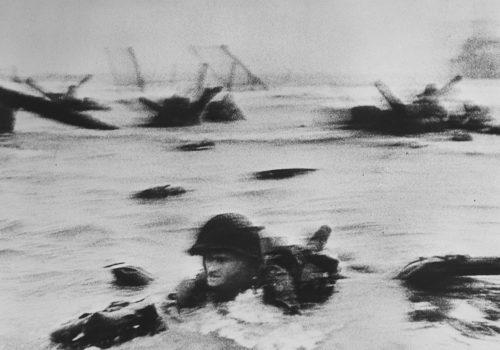On the occasion of the 80th anniversary of the Allied landings in Normandy, Icônes by Robert Capa at the Franciscaines convent in Deauville.
A sublime exhibition in partnership with the Magnum photos agency that we owe to his biographer Michel Lefebvre. He also wrote this presentation text:
On December 3, 1938, the English newspaper Picture Post hailed “The greatest war photographer in the world: Robert Capa”. The caption under the title is a vibrant tribute to Capa: “In the following pages you will discover a series of images from the Spanish Civil War. Regular Picture Post readers know that we rave about the work we publish. We present these images simply because they are the best from the front line ever taken. They are by Robert Capa. He is Hungarian by birth, but being short and dark-skinned, he is often mistaken for a Spaniard. He loves working in Spain more than anywhere in the world. A fervent democrat, he makes his living from his photos. More than a year ago Capa’s partner, was killed in Spain whereas she was supposed to join him in Paris. (…) Today he is back in Spain, taking photos for Picture Post. » There is everything in this tribute, all the magic of a photographer who seduced the world with his work on Spain when he literally did not exist three years before. Robert Capa covered five wars, Spain, China, the Second World War, Israel, Indochina, and each time brought back the best images, those that count and remain in history. He is not at the origin of photojournalism but of what I call modern photojournalism, that which appears with the development of handy cameras like the Leica and the illustrated press. He enjoyed success from the start of the Spanish Civil War in 1936. His pseudonym was invented shortly before, with his friend, the German refugee Gerta Pohorylle. She became Gerda Taro and he, the stateless Hungarian Endre Friedmann, became Robert Capa. From this time, because he saw how his colleagues were exploited and their names made invisible, he was obsessed with the idea of defending the work of photo reporters: selling their photos directly to newspapers and not selling them off to an agency that did not mention their signature, he wanted to keep the prints and negatives, and the right to check the captions that accompanied the photos. This is also modern photojournalism. These ideas would lead much later, in 1947, to the creation of the Magnum Photos cooperative with his friends David “Chim” Seymour, Henri Cartier-Bresson, George Rodger and William Vandivert. No photographer has generated as much interest, publications, discussions, even controversies as Robert Capa. When he died in April 1954 in Indochina, he owned nothing apart from a few suits, cameras and English editions of novels that he liked to read in his bath. His refuge was a small room that he rented under the roof of the Lancaster hotel, rue de Berri in Paris. He lived there between reporting, poker games and betting on the racetracks. He left tens of thousands of photos scattered around the world after fleeing to the United States in the fall of 1939 in the face of the threat of war. Cornell Capa (1918-2008), his brother, spent his life searching for them and reconstructing his work by any means possible. Most of the work around Capa was done on his initiative, and that of Richard Whelan (1946-2007), the historian he chose to build the legend, and of John G. Morris who participated throughout his life to this work of memory. On the sidelines of this official history, very rich but full of gray areas, Robert Capa has been the subject of numerous independent studies. To get a closer look at the work of IN SEARCH 2 BY ROBERT CAPA Robert Capa, this exhibition presents around 150 period documents: original prints, newspapers, books, objects mainly from the Golda Darty collection and the Magnum Photos archives. Most exhibitions offer very large format prints, retouched, sometimes cropped, carefully framed like works of art. The period print, even with their imperfections, demonstrates much better, like the publications in newspapers, the work of the press photographer. Having access to one of his Leica cameras or his indefinably charming prints allows you to understand the photographer’s world and explain his work. What we wanted to show first is how, why and where he took his photos. This seems obvious, but it is not necessarily so as his life is a treasure hunt. We also show how images are made. A photo is an interpretation of reality, a point of view that the photographer has chosen to bear witness to, but it is also a physical object. We Explain how a photo gets from the place where it was taken to the newspaper that will publish it, how it travelled thousands of kilometers, by car, by train, by plane, and why, in the 1930s, the speed of transmission of images was accelerating, which is also one of the conditions for the development of modern photojournalism. Finally we show that Capa also handled color photography as a lover of life and produced endearing portraits, fashion shots, film shoots or travel shots: from Deauville to Biarritz, from the Alps to Budapest. »
Michel Lefebvre, curator of the exhibition
Robert Capa : Icônes
May 25 – October 13, 2024
Les Franciscaines
145 B, Avenue de la République
14800 Deauville
https://lesfranciscaines.fr
Also look at this Magnum newsletter dedicated to its founder.
https://www.magnumphotos.com/newsroom/the-ageless-changeless-robert-capa/?utm_source=Audience&utm_campaign=7eeeac939e-Field_Notes_180524_COPY_01&utm_medium=email&utm_term=0_237144cbf5-7eeeac939e-5871551&mc_cid=7eeeac939e&mc_eid=38855e7446
Finally, note the exhibition catalog published at Atelier EXB:
Robert Capa : Icônes
Release June 13, 2024
Direction and texts
Michel Lefebvre,
Journalist at Le Monde,
specialist of Robert Capa
Technical sheet
Hardcover, 19.5 × 27 cm
192 pages
150 B&W photographs and numerous archive documents
ISBN: 978-2-36511-400-4
Price: €45 including tax
This book received the support of Golda Darty
















